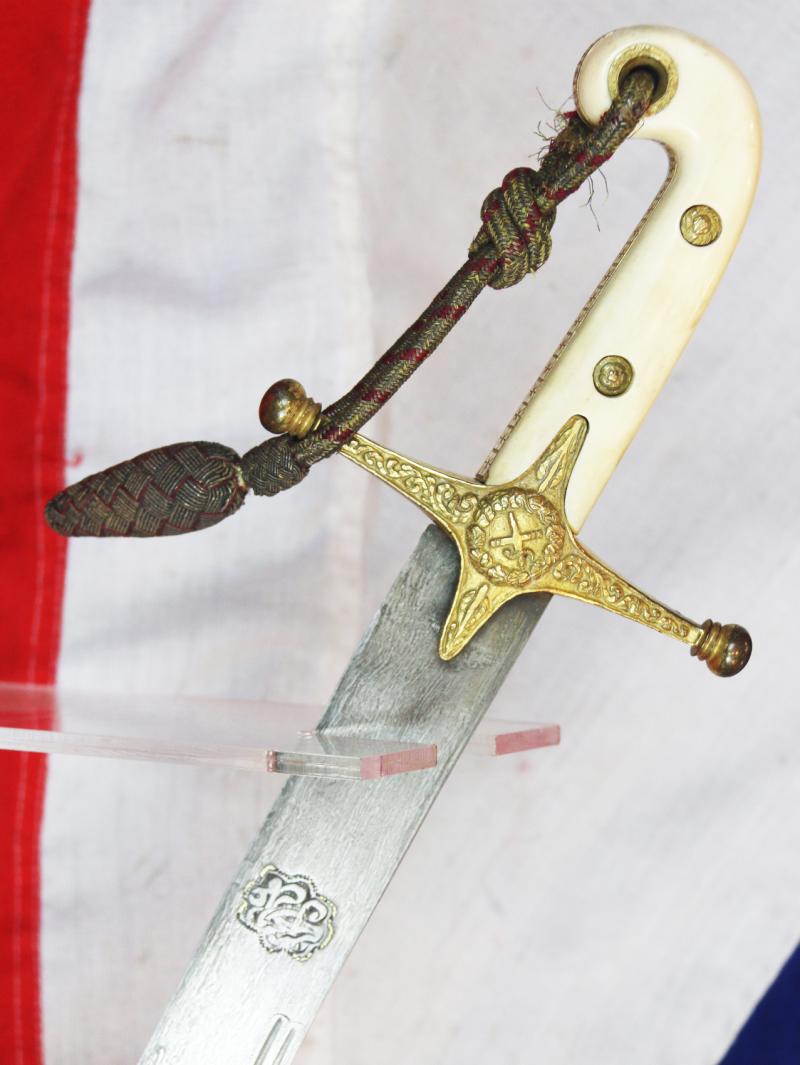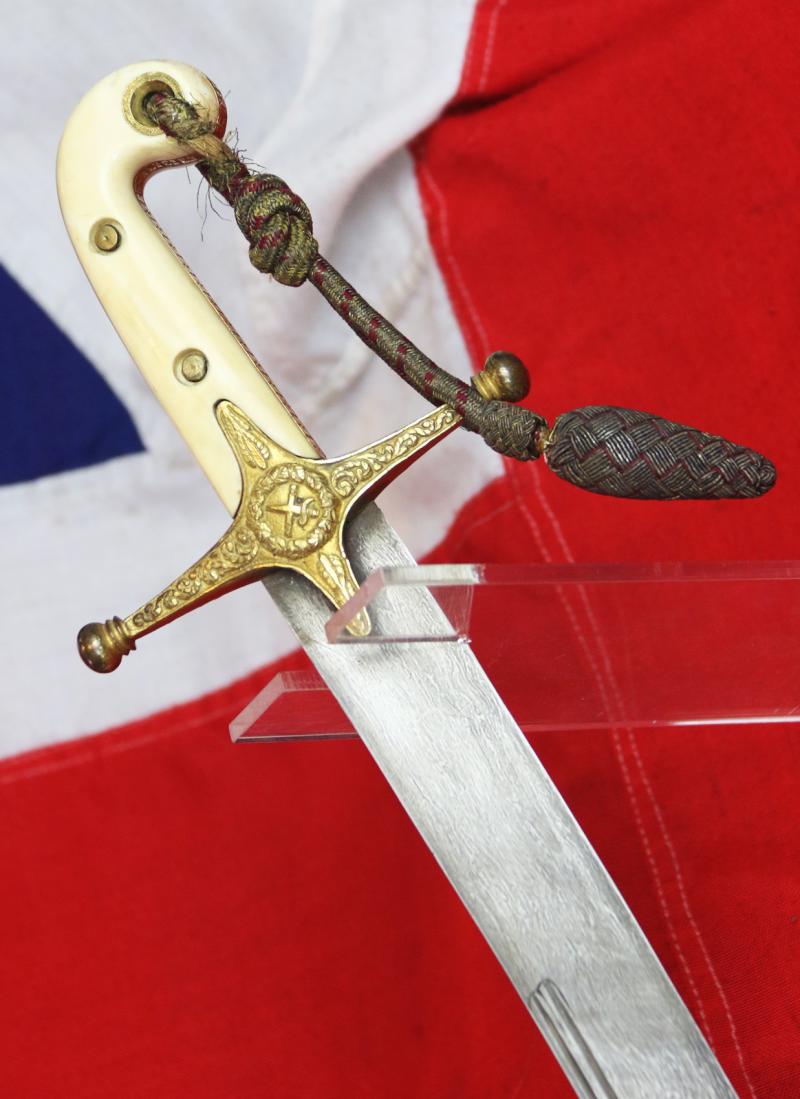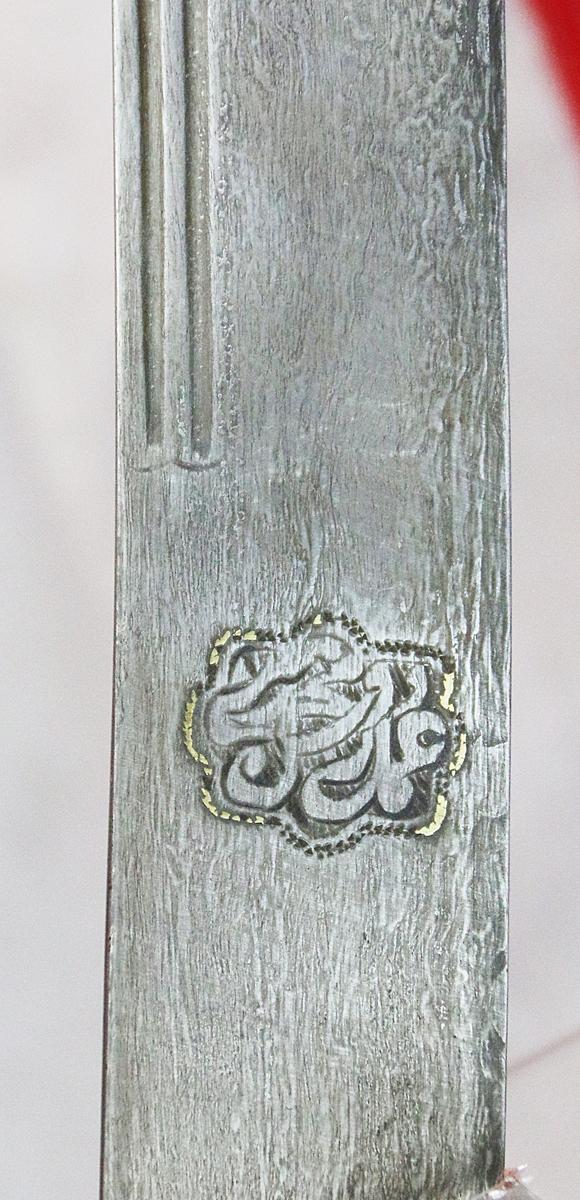A Most Fine and Rare Victorian British General's Mamaluke With a Captured Battle Trophy, or Presentation, Spectacular, Indian, Damascus Steel Blade, With Islamic Gold Cartouche Seal Engraved and Inlaid With Gold, 'Mohammed, Blessings Be Upon Him'
Traditional British Mamaluke pattern hilt in gilt bronze, with ivory grips and gilt rossettes, original gilt bullion sword knot. The central crest between the quillon is a General's crossed baton and sabre symbol. The scabbard is formed gilt brass, of the usual generals pattern, but made extra wide than is usual to bespoke fit the fine wide blade.
The kind of fantastic sword & highest quality wootz water pattern Damascus blade that would have been used by a British General such General Havelock, General Nicholson of Delhi, or General Sir James Outram, from the the Crimean War or the Indian Mutiny period.
The sword would have normally been fitted with a standard etched blade, but a few, usually very notable generals of fame and status, might have a presentation or captured blade such as this fitted for their mamaluke. The cartouche reads approx, 'Mohammed, Blessings Be Upon Him'
Mameluke swords were adopted by officers of light cavalry regiments in the first decade of the 19th century, The current regulation sword for generals, the 1831 Pattern, is a Mameluke-style sword.
Napoleon raised a number of Mameluke units during his Egyptian campaigns in the French Revolutionary Wars, leading to the adoption of this style of sword by many French officers. In the post-Napoleonic period French military fashion was widely adopted in Britain.
The Duke of Wellington carried a Mameluke sword from his days serving in India and throughout his career. After he defeated Napoleon his status was a national hero, Commander-in-Chief of the Forces, and then prime minister; as such, his tastes had considerable weight.
Trade between India and Sri Lanka through the Arabian Sea introduced wootz steel to Arabia. The term muhannad مهند or hendeyy هندي in pre-Islamic and early Islamic Arabic refers to sword blades made from Indian steel, which were highly prized, and are attested in Arabic poetry. Further trade spread the technology to the city of Damascus, where an industry developed for making weapons of this steel. This led to the development of Damascus steel. The 12th century Arab traveller Edrisi mentioned the "Hinduwani" or Indian steel as the best in the world. Arab accounts also point to the fame of 'Teling' steel, which can be taken to refer to the region of Telangana. The Golconda region of Telangana clearly being the nodal centre for the export of wootz steel to West Asia.
Another sign of its reputation is seen in a Persian phrase – to give an "Indian answer", meaning "a cut with an Indian sword". Wootz steel was widely exported and traded throughout ancient Europe and the Arab world, and became particularly famous in the Middle East.
From the 17th century onwards, several European travellers observed the steel manufacturing in South India, at Mysore, Malabar and Golconda. The word "wootz" appears to have originated as a mistranscription of wook; the Tamil language root word for the alloy is urukku.17 Another, which theory says that the word is a variation of uchcha or uchadubious ("superior"). According to one theory, the word ukku is based on the meaning "melt, dissolve". Other Dravidian languages have similar-sounding words for steel: ukku in Kannada1819 and Telugu, and urukku in Malayalam. When Benjamin Heyne inspected the Indian steel in Ceded Districts and other Kannada-speaking areas, he was informed that the steel was ucha kabbina ("superior iron"), also known as ukku tundu in Mysore.
Legends of wootz steel and Damascus swords aroused the curiosity of the European scientific community from the 17th to the 19th century. The use of high-carbon alloys was little known in Europe22 previously and thus the research into wootz steel played an important role in the development of modern English, French and Russian metallurgy.23
In 1790, samples of wootz steel were received by Sir Joseph Banks, president of the British Royal Society, sent by Helenus Scott. These samples were subjected to scientific examination and analysis by several experts.242526
Specimens of daggers and other weapons were sent by the Rajas of India to the Great Exhibition in London in 1851 and 1862 International Exhibition. Though the arms of the swords were beautifully decorated and jeweled, they were most highly prized for the quality of their steel. The swords of the Sikhs were said to bear bending and crumpling, and yet be fine and sharp
We show several images from portraits or statues in the gallery of 19th century British Generals, all with identical swords
The statue of General Havelock in Trafalgar Square, London British General such as Nicholson Of Delhi, with his identical sword
A statue of Sir James Outram by Matthew Noble, in Whitehall Gardens, London
+ The portrait of General Havelock
Antique ivory, 'worked' declaration submitted, but we can only sell this sword within the UK, it is not allowed for export. Ivory, however old cannot be imported into the USA.
ref; Manouchehr Moshtagh Khorasani 750 page tome on Arms and Armour, Wootz patterns, page 540
Code: 25361
6950.00 GBP




